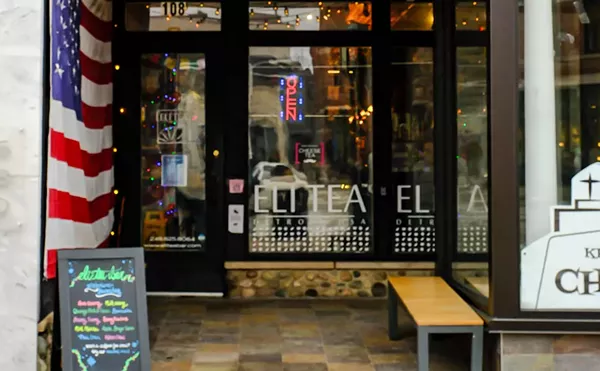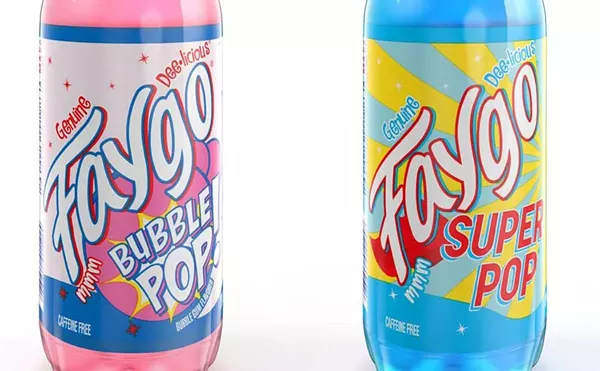A main reason to eat a pupusa is the outsides — more, in my opinion, than the filling. This Salvadoran national dish is a thick, handmade corn tortilla stuffed with cheese or more. A handmade tortilla is night-and-day different from the thin floppy kind from the factory. You can barely find a handmade tortilla anymore, the store-bought kind having liberated women in Mexico and Central America from hours spent softening corn kernels in lime water, grinding them into masa, patting them into shape, and frying them on a comal.
When I lived in Guatemala City in 1986, as you walked down the street you'd hear "slap, slap, slap" from innumerable doorways, either tiny restaurants or private homes, as girls and women efficiently prodded the dough back and forth, hand to hand, spreading it a bit with each slap. It was a comforting sound that produced comfort food. Tortillas and black beans, with a bit of crema, were all you needed for a meal (though that's easy to say for someone who could afford more).
I wasn't always crazy about the pupusas' contents at the new Salvadoran pupusería on the southwest side, but I always liked the tortilla. Options are any combinations of queso (cheese, the simplest and best), beans, chicharron (ground pork, not the fried pork rinds usually called chicharron in a Mexican restaurant), bright-green squash and loroco, a flower.
It helps to know Spanish here, but it isn't essential; the menu has translations, and your waitress, who, along with her sister, the cook, is from El Salvador, is supremely welcoming. One evening we sat near a party of friendly Guatemalan barbers who bought me a licuado. It's barebones basic, with just three flags and a large TV tuned to telenovelas for decor.
There's much more than pupusas on the menu, of course, for Central Americans seeking a taste of home or for Mexicans or gringos who want to branch out. Standouts are tamales of chicken, spicy pork or corn. These are the rectangular, moist kind, well-stuffed, not the dry cylinders that are much more common in Mexicantown. The white corn (elote) tamal is quite different: sweet and served with a barely sour crema, imported from El Salvador.
The excellent horchata, perhaps the best I've tasted anywhere, is made from milk and morro seeds, also from El Salvador. I found it almost mild-chocolate in effect, very slightly nutty. (Bonus natural history fact: if you look up morros under Crescentia alata in Wikipedia, you will find a fascinating discussion of how their seeds were dispersed during the Pleistocene Age by elephant-like animals with the inspired name of Gompotheres, as they gomped through the jungle.)
Also not to be missed are fried platanos, a dish made in heaven. It consists of seven warm, fat, sweet perfectly browned platanos, served in the traditional manner with a pool of warm puréed black beans and another pool of cooler crema. It's important to get all three in each bite.
For more entrée-like dishes, you can try the misleadingly named "fried chicken dumplings" (pasteles de pollo), which are half-moon-shaped empañadas, or fried yuca with chicharrón, which this time is pork cubes. Let's not mince words: this is fried food; the yuca is like big wedges of French fries, but with a pleasingly subtle taste.
For more choices, visit on Friday, Saturday or Sunday, when specials are available (but it wouldn't hurt to call ahead and request what you want, as the popular dishes are often terminado). I did this on a recent Sunday, and had big bowls of chicken soup and beef soup set aside for me. These are not first-course soups but enough for a meal, served with handmade tortillas. Caldo de gallina (chicken) is all dark meat, with carrots, squash, potatoes and a bit of rice in a rich broth. It's accompanied by a salad, still another piece of chicken, fried, and excellent rice with peas and carrots, which is why, I suppose, it's the most expensive dish at $10. The $7 beef (res) soup is similar, but incorporates an ear of corn. Chicken and beef guisado are the other specials.
Everything is served with curtido, a cabbage slaw with either carrots or, the fancier version, carrots, tomatoes and jalapeños.
If you're not drinking horchata, jamaica or tamarindo, or Jarritos, the Mexican pop, I recommend a licuado, which is bananas or fresh strawberries or both in a blender with milk, tall and thick, with cinnamon on top. Next on my list to try is atol de elote, an ancient hot drink made from puréed corn off the cob. There's no liquor license.
By the way, our waitress says you might see Mexicans eating pupusas with a knife and fork, but the Salvadoran way with this street food is con los dedos — with the fingers.
To watch how tortillas are made by hand, go to bit.ly/9QtifP.
Jane Slaughter dines for Metro Times. Send comments to her at [email protected].







